
|
HOME  ARTICLES & PRESENTATIONS  PROJECTS  SOCIETY INFO  FAKES & FANTASIES  PHOTO ALBUM  NEWS ARCHIVE  ICP ARCHIVE  EXHIBITS 
APS Affiliate #38 |
Why I Collect Laos
by Mike Johnson Note: Some of the illustrations have been omitted to improve viewing online. Please refer to the original article in the May/July 2000 issue of the Indo-china Philatelist (issue 143) to reference all of the images. The images appear here in grayscale as they were extraced from the printers file. Why do I collect Laos? Probably it's because I've always been visually oriented. I enjoy art of all kinds -- paintings, sculptures, nature (flora and fauna), landscape design, architecture, and beautiful women. And, of course, the stamps of Laos have all of the above -- they have real "eye appeal!" This is not to say that the stamps of French Indochina, Cambodia, Vietnam, and Thailand are not as interesting or beautiful, but Laotian stamps (meaning the Kingdom of Laos) are still the most beautiful and exciting stamps that I collect. Surely, there are other SICP members who feel the same way. My discovery of the beauty of Laos and its stamps took place over thirty years ago. From that beginning, my collecting interests in the region rapidly expanded to include French Indochina, Cambodia, both Vietnams, Thailand, and the rest of the Far East. Looking over my collection of Laos, which includes stamps, souvenir sheets, covers, postcards, and just about anything else printed on paper, I rediscovered the same joy of possessing these beautifully designed and printed works of art - with their variety of interesting subjects reflecting the beauty and diversity of the country and people of Laos. When the territory later known as the Kingdom of Laos was founded in the 13th Century, it was called "Lane Xang" or the "land of a million elephants." The emblem of the Kingdom, the three-headed elephant, appears in white on the red background of the Laotian flag (see emblem at lower left on map of Laos in Figure 1). By 1885, the French had obtained control of the territories of Annam, Tonkin, and Cochin China -- known collectively as the Union of Indochina -- and they soon desired to extend their rule westward to the Mekong -- territory then claimed by Siam. In October 1893, Siam was forced by the French to relinquish control of all its territory east of the Mekong River; much of the land that was to become Laos. 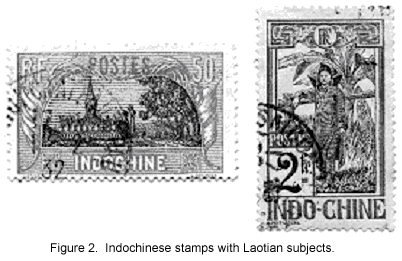 Laos used the stamps of French Indochina until 1951. A Laotian woman is pictured on the 5-franc value from the 1907 pictorial set of Indochina (Scott #57), and That Luang in Vientiane is pictured on two values of a 1927 Indochina set (Scott # 135-36). These early Indochina stamps are shown in Figure 2. In my collection is an early registered Indochina cover (shown in Figure 3) franked with two Scott #75 and one #77 (these stamps picture a Cambodian girl) and mailed from Luang Prabang, Laos to Chicago.
Laos used the stamps of French Indochina until 1951. A Laotian woman is pictured on the 5-franc value from the 1907 pictorial set of Indochina (Scott #57), and That Luang in Vientiane is pictured on two values of a 1927 Indochina set (Scott # 135-36). These early Indochina stamps are shown in Figure 2. In my collection is an early registered Indochina cover (shown in Figure 3) franked with two Scott #75 and one #77 (these stamps picture a Cambodian girl) and mailed from Luang Prabang, Laos to Chicago.
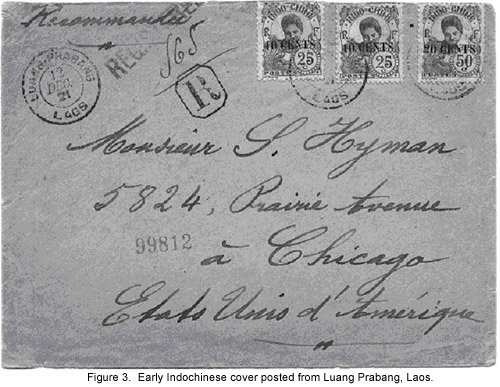
The letter was postmarked 12 December 1921 at Luang Prabang, and traveled via Hong Kong where it was backstamped on 13 January, and was finally received in Chicago on 17 February 1922. Mail from the Far East was apparently a lot slower in those days before airmail, traveling by land (sometimes by elephant -- see Laos Scott #79), or via riverboat to an ocean port, where an ocean steamer picked up mail for the long journey to North America or Europe. After the Japanese occupation of Indochina during World War Two, and the return of the French in 1946, the Kingdom of Laos was guaranteed its democratic freedom by the constitutional proclamation of 10 May 1947. King Sisavang Vong (see Scott # 7) was chosen to rule the new Kingdom. Figure 4 shows a cover, which was issued in mid-1943 during the Japanese occupation, franked with a set of two Indochinese stamps (Scott #227-228) picturing King Sisavang Vong. This unaddressed philatelic cover was postmarked at Vientiane, Laos on 14 August 1944. It bears a cachet, actually an enlarged version of the stamp picturing Sisavang Vong with a small caption beneath the picture indicating that he is the King (Roi) of Luang Prabang. (Note the three-headed elephant emblem appearing above the King's head on the stamp and cachet). However, another caption in larger print appears below the illustration -"S.M. Sisavang Vong, Roi du Laos" -- suggesting that Sisavang Vong was considered the de facto King of Laos three years before the French granted the state independence within the French Union in May 1947. It should be noted that during this same time period, while Indochina was under Japanese control, similar stamps were issued showing Bao-Dai as Emperor of Annam (see Indochina #223-4), and Norodom Sihanouk as King of Cambodia (see Scott #225-6.) The king remained in his old capital of Luang Prabang, where he had ruled since 1904, until his death on 29 October 1959. His passing was acknowledged with a postal issue (see Scott #69 in Figure 5) and it was again commemorated 10 years later (see the two Laos stamps, Scott #194-195, issued on the 10th Anniversary of the King's death, Figure 6). Laos was declared an independent state within the French Union on 22 October 1953, but did not become fully independent until 7 December 1956, well after the end of the prolonged Indochina War. An International Control Commission (ICC) for Indochina was established as part of the Geneva Declaration partitioning Vietnam in August 1954, to help achieve stability in the newly independent states of Laos, Cambodia, and Vietnam. The three supervisory commissions were chaired by India, Canada, and Poland, and joint inspection teams were established that included servicemen from each of the three ICC countries. The Indian Contingent was charged with handling the mail for the three contingents of ICC inspectors, and Indian field post offices were established in late 1954 at Saigon, Hanoi, Vientiane, and Phnom-Penh. A first day cover of the Indian Army Post Office in Vientiane, Laos, postmarked 1 December 1954 is shown in Figure 7. The ICC inspection teams remained in place until 1968. 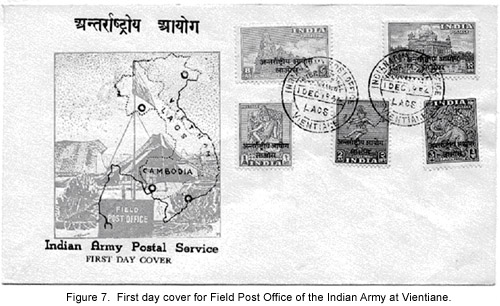
The Kingdom of Laos issued its first postage stamps on 13 November 1951 with a beautiful set of 17 pictorials (Scott # 1-17). The designs included a boat on the Mekong, a Laotian woman, the old capital of Luang Prabang, a temple in Vientiane, and a portrait of King Sisavang Vong. An early cover with examples of these first stamps is presented as Figure 8. 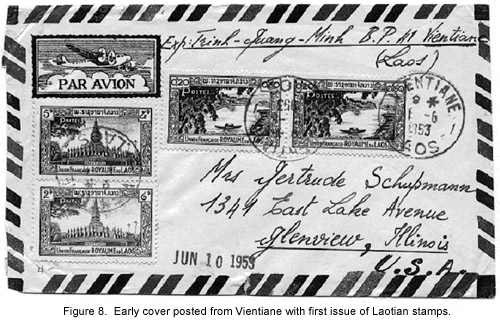
These were followed on 13 April 1952 by the issuance of the first four airmails (Scott C1-4), picturing a Laotian girl weaving, and Wat Pra Keo. In addition, a set of six postage due stamps (Scott J1-6) were issued. Without doubt, these first pictorials and airmails are the some of the most beautiful stamps ever issued by Laos. They were designed by Marc Leguay, an extremely talented artist who was responsible for designing many Laotian stamps during the next two decades. In 1952, Laos also issued a special booklet containing 26 souvenir sheets, each containing a single stamp of the first issues (Scott #1-17, C2-4, and J1-6) This booklet is a miniature art gallery of some of the best designed and engraved stamps in the world. Because it is valued at about $100, this item is not yet in my collection, but certainly is high on my want list. Twenty years later, in November 1971, Laos issued three stamps and an airmail souvenir sheet (Scott #223-25 and C84), with designs similar to the stamps issued in the early 1950s, to commemorate the 20th Anniversary of Laotian Stamps. All of these stamps, except one were designed by Marc Leguay. At this time, a new designer had appeared on the Laotian stamp scene -- Chamane Prisayane -- who like Leguay would design many of Laos' stamps in the following years. Shown nearby is the souvenir sheet from this issue (see Figure 9). More beautiful stamps soon followed these first issues, most notable among them are Scott #25-26, and C13, issued on 4 March 1954, 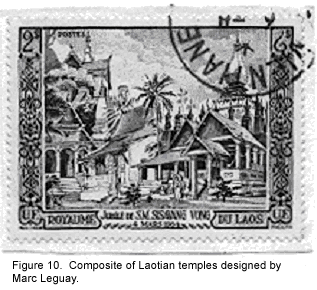 each showing a composite design of Laotian temples by Marc Leguay (shown at the right is a used example of Scott #25 in Figure 10), and commemorating the 50th anniversary of the accession of King Sisavang Vong. These absolutely gorgeous stamps are the "Cadillacs" in my Laos collection (because it took me almost 30 years to get them.) Other beauties issued during the 1950s include sets picturing Laotian musicians and instruments in beautiful colors (Scott #34-36, C24-26), harvesting rice (Scott #37-40), and various elephants at work (Scott #41-47) -- all designed by Leguay.
each showing a composite design of Laotian temples by Marc Leguay (shown at the right is a used example of Scott #25 in Figure 10), and commemorating the 50th anniversary of the accession of King Sisavang Vong. These absolutely gorgeous stamps are the "Cadillacs" in my Laos collection (because it took me almost 30 years to get them.) Other beauties issued during the 1950s include sets picturing Laotian musicians and instruments in beautiful colors (Scott #34-36, C24-26), harvesting rice (Scott #37-40), and various elephants at work (Scott #41-47) -- all designed by Leguay.
A set picturing historic Laotian monuments in Savannakhet, Pakse, Vientiane, and Luang Prabang (Scott #60-65) designed by Leguay and Prisayane was also issued. Also issued were at least four sets of airmails, including one showing various statues of Buddha (Scott #C712), scenes from the Ramayana (Scott # 14-19), Laotian monks and the Smiling Buddha (Scott #C27-30) by Leguay, and various tourist spots in Laos, including the famous Plain of Jars in Xieng Kouang (Scott # C35-38). When King Sisavang Vong died in 1959, he was succeeded by King Savang Vatthana (see Scott # 70-73, Figure 11). Following a bloodless coup in Vientiane on 8 August 1960 led by Captain Kong Le, the King agreed to install Prince Souvanna Phouma as Prime Minister. 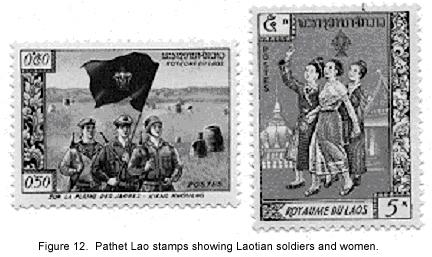 In December 1960, Kong Le was defeated by General Nosavan, who installed Prince Boum Oum as the head of government in Vientiane. Kong Le and his forces fled to the Plain of Jars with Souvanna Phouma's cabinet and joined the Pathet Lao (Lao country) to establish a neutralist government. In 1961 the Pathet Lao issued a set of eight stamps (Stanley Gibbons #N1-8) with two designs -one picturing soldiers with the Laotian flag on the plain of Jars, and another showing Laotian women with an emblem of the three-headed elephant (see Figure 12).
In December 1960, Kong Le was defeated by General Nosavan, who installed Prince Boum Oum as the head of government in Vientiane. Kong Le and his forces fled to the Plain of Jars with Souvanna Phouma's cabinet and joined the Pathet Lao (Lao country) to establish a neutralist government. In 1961 the Pathet Lao issued a set of eight stamps (Stanley Gibbons #N1-8) with two designs -one picturing soldiers with the Laotian flag on the plain of Jars, and another showing Laotian women with an emblem of the three-headed elephant (see Figure 12).
Although these stamps were accepted throughout much of the territory, particularly in the north, where some mail was routed through China, they were not recognized by Thailand, which required that letters bearing these stamps also be franked with stamps from the Royal Laotian Government. As the influence and territory controlled by the Pathet Lao grew, the King was persuaded on 22 June 1962, in accordance with the Geneva Conference on Laos, to install a new coalition government in Vientiane under Souvanna Phouma. But the coalition government was short-lived and, on 1 June 1964, the Pathet Lao withdrew their officials from Vientiane. A state of civil war developed, and the fighting in the North became increasingly involved with the Vietnam War. Figure 13 presents a three-stamp set, issued by the Pathet Lao after the war, showing Pathet Lao soldiers (note the flag), a burning village, and an antiaircraft battery shooting down an airplane. On 2 December 1975, the Pathet Lao forced the resignation of the Royal Laotian Government and the abdication of King Savang Vatthana, proclaiming the People's Democratic Republic of Laos under the rule of Prince Souphanou-Vong, the Chairman of the Pathet Lao. A three-stamp set was issued in February 1975 (Scott #258-259), showing portraits of King Savang Vatthana, Prince Souvanna Phouma, and Prince Souphanou-Vong. A gold foil souvenir sheet with the same design was issued in June 1975 (Stanley Gibbons #MS 419), honor the "First Anniversary of the Laotian Peace Treaty." This souvenir sheet is also shown in Figure 14. During the late 1960s and early 1970s, Laos issued several interesting sets of stamps picturing its flora and fauna. A beautiful set of four large-size stamps adorned with butterflies (Scott #101-103, and C64) was issued in 1965. In 1967, Laos issued three different four-stamp sets; one showing fish (Scott 148-151), another picturing the beautiful flowers of Laos (Scott #152-155), and even a set showing various reptiles (Scott #156-159). This theme continued in 1968, with a set of four stamps showing insects (Scott #171-173), and another set showing various fruits of Laos. All these were designed by S. Rodboon. A rather beautiful set of wild animal stamps, especially the airmails, was issued in 1969 (Scott #192-193, and C59-61), and was designed by Ky Phungchaleun. In 1970, another set of more exotic animals was issued, also designed by Ky Phungchaleun (Scott 203-204, and C70-71). A third series of wild animals (Scott #219-222, C83) by Phungchaleun appeared in 1971. A beautiful set of four stamps picturing orchids of Laos (Scott 21~218, C79) also appeared in 1971. In 1966, a devastating flood struck Vientiane and other areas of Laos along the Mekong. A set of three semi-postals (Scott # B6-8) was issued in 1967 for the relief of victims of the Mekong Delta Flood. The stamps picture a flooded village and marketplace, and the airport in Vientiane. Several years later, in September 1973, an airmail stamp (Scott #C107) was issued showing Laotian Scouts helping victims during the 1966 Vientiane flood. The two-stamp set (C106-107) commemorates the 25th anniversary of the Laotian Scout movement. I've saved the best and most beautiful stamps for last -- a series of paintings by Marc Leguay and Chamnane Prisayane -- showing the beauty of Laos and its people. All twelve of these colorful airmail stamps, which appeared between 1969 and 1972 were issued in large format. Ten of Marc Leguay's paintings were issued as four series of stamps -- Scott C62-64 (25 December 1969), C64 (8 April 1970), C72-74 (21 December 1970), and C96-100 (23 December 1972) -- all picturing typical scenes from Laotian life. Isn't it interesting that three out of the four series of stamps were issued just before Christmas? They probably made really nice Christmas presents for collectors of Laos's stamps. And, I offer just one last item from my collection (see Figure 16). The cover is franked with two gorgeous stamps showing paintings by Chamnane Prisayane (C85-86), "Sunset over the Mekong," and "Quiet Morning at Ban Tone Pieo," which is the way I will always remember Laos. References: 1. Map of Laos by Service Geographique National, Vientiane, Laos, appearing in a 1968 USIS publication. 2. Scott Standard Postage Stamp Catalog, 1998, Vols. 3 and 4, Scott Publishing Company. 3. Stanley Gibbons Stamp Catalogue, Part 21, Southeast Asia, Third Ed., 1995. 4. Dommen, Arthur J., Conflict in Laos -- the Politics of Neutralization, 1964, Frederick A. Praeger Publishing, New York, Third Printing 1967. Entire Contents ©1999-2021 Society of Indo-China Philatelists. All Rights Reserved - Site managed by Larry Fillion. |